
Today was another fun day at school. After a full day of teaching at Tanigawa Junior High School, I took a bike ride over to Sanga Elementary school, where I was scheduled to teach a workshop on elementary English lesson planning and teaching.
Last year in Japan, 35 English classes (or “foreign language classes” as they’re officially known) per year became mandatory for 5th and 6th grade elementary school children. This has caused many schools considerable logistical difficulties considering that many teachers in Japan do not receive the basic support or training they need to effectively teach the English language.
As part of an effort to ease the pressure this has put on my city, I have been leading regular workshops about English teaching for the past year. These workshops generally focus on teaching methodology, classroom management, and choosing appropriate topics. These are topics I often speak about at Osaka JET Skills Development Conferences, and I absolutely love doing them for Japanese teachers in my city. It’s such a fulfilling experience to see a teacher communicate information to a student, watch a student understand and reproduce that information, and know that you played some part in that process.
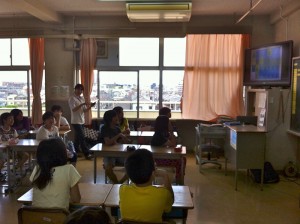 Today’s workshop was 6 new teachers, me, and an Apple TV. We all took turns comparing notes and experiences from our recent classes. For many of the new teachers who come to these classes, it is their first time teaching English on their own. They have no training in EFL, or the basic ability to speak english themselves, so the classes are really challenging for them.
Today’s workshop was 6 new teachers, me, and an Apple TV. We all took turns comparing notes and experiences from our recent classes. For many of the new teachers who come to these classes, it is their first time teaching English on their own. They have no training in EFL, or the basic ability to speak english themselves, so the classes are really challenging for them.
What I am always surprised about, is how thoughtfully the teachers consider the advice I give them, and apply it to their classrooms. This time around, my advice to them had been to keep up a high speed pace, but remain vigilant and mindful of the students and whether or not they understand what’s going on. I told them to watch their students’ faces, because their faces show whether they understand or not.
I also reminded them that doing too much “repeat after me” is not productive and hinders the students from critically thinking and truly communicating. Unfortunately, this is the standard practice for English class in Japan, and it’s difficult to get teachers here to do something a different way than the only way they’ve ever seen it done in their entire lives.
With the chance to meet as a group, regularly, I’ve seen some amazing improvements. I’m genuinely surprised at some of their thoughts and ideas. Really, it’s just a matter of equipping new teachers with direction and advice regarding implementation. I feel that the best way that I can help them is just to let them know what has worked for me and what has failed for me. I also feel fortunate that we have been able to work in this collaborative fashion. I always feel there is a desire to improve the quality of our students’ educations, sometimes it’s just a matter of getting the time to do it.

今日は、また学校での楽しい一日となりました。谷川中学校での一日の授業の後、初等英語の授業計画と教育についての勉強会が予定されていた山箇小学校まで自転車を走らせました。
昨年、日本では、一年間に、35回の英語の授業(又は、公式には“外国語教育”で知られている )が、5年生と6年生の必須科目となりました。日本の小学校教師の多くは、英語を教育するにあたり、効果的な訓練や、基本的なサポートを受けていないことを考えると、これは、多くの学校において、深刻な問題の原因となっています。
私の市に伸し掛った圧力を和らげるための取り組みの一つとして、この一年、私は、英語教育についての定期的な勉強会を指導してきました。これらの勉強会では、通常、教育方法論、教室内での管理、そして、ふさわしい課題の選択などに焦点を当て行いました。これらの課題については、大阪JETのSkills Development Conferences(専門知識発達のための会議)でよく講義する内容で、それを私の市で、日本人教師たちにその話ができることは、本当に嬉しいです。生徒に関する内容を話し合ったり、理解する生徒を見て、新たに情報を再生する、そしてその中の過程に自ら携わっていると自覚する教師を見るのは、私にとって、本当に充実感のある経験であります。
 今日の勉強会は、6名の新しい先生方と、私、そしてApple TVを使用して行われました。最近の授業を元に、皆さん、それぞれに自らの経験を語り、比較しました。これらの授業に参加した新しい教師の多くは、英語教育自体が初めてでした。EFL(外国語としての英語)の訓練経験や、彼ら自身英語を話す基本的な能力もない彼らにとって、これらの授業は、本当に困難なものです。
今日の勉強会は、6名の新しい先生方と、私、そしてApple TVを使用して行われました。最近の授業を元に、皆さん、それぞれに自らの経験を語り、比較しました。これらの授業に参加した新しい教師の多くは、英語教育自体が初めてでした。EFL(外国語としての英語)の訓練経験や、彼ら自身英語を話す基本的な能力もない彼らにとって、これらの授業は、本当に困難なものです。
私が、いつも驚かされることは、私が彼らにするアドバイスや、彼らの授業にそれ取り入れていくための意見に対して、本当に思慮深く考える先生方の姿勢です。この頃、彼らに対しての私のアドバイスは、ハイスピードで行われていますが、生徒たちが状況を理解しているか、していないかに限らす、生徒の配慮と気遣いを忘れてはなりません。そして、彼らを生徒のところへ連れて行き、生徒たちの表情を見てもらいます。生徒の表情を見れば、彼らが理解しているかどうかが分かるからです。
そして、「Repeat After me」のやり過ぎは、生徒たちのクリティカルシンキングや、本来の会話を妨げ、有効的ではないということを注意しました。残念ながら、これは、日本の英語教育の典型的な練習法です。そして、教師たちに、彼らの人生において、これまで見てきたこと以外の方法を実施することを求めることは本当に難しいことなのです。
定期的にグループとして集まる機会があることにより、これまでに素晴らしい成果が見られました。彼らの意見とアイデアのいくつかには、本当に驚かされます。実際に、それらは、その実行に伴う新しい教師たちの方向性とアドバイス次第で決まることなのです。彼らの役に立つための一番の方法は、私のうまいった経験と、うまく行かなかった方法を分かってもらうということです。私は、この共同研究的方法で、お互いが協力できることをとても幸運であると感じでいます。そして、私は、いつも生徒たちの教育の質の上げるという願いは、本当に、それにかかる時間次第だと思っています。
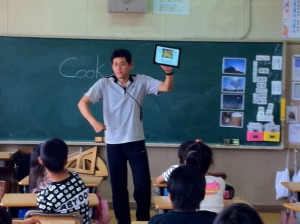 This Friday, I was teaching at Sanga elementary school. It was my first time to visit and see these particular students, so I had the chance to do the infamous “jikoshokai” (or, self introduction), before getting into teaching them the alphabet.
This Friday, I was teaching at Sanga elementary school. It was my first time to visit and see these particular students, so I had the chance to do the infamous “jikoshokai” (or, self introduction), before getting into teaching them the alphabet.
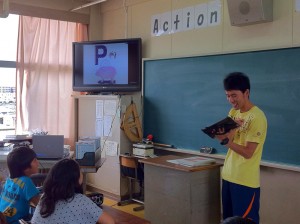 The homeroom teachers did a fantastic job, and their use of the device looked really natural. Sanga’s principal visited all of our lessons, and continues to show his interest in these classes paying off. It’s encouraging knowing that support is there for these teachers from the top administrator at Sanga.
The homeroom teachers did a fantastic job, and their use of the device looked really natural. Sanga’s principal visited all of our lessons, and continues to show his interest in these classes paying off. It’s encouraging knowing that support is there for these teachers from the top administrator at Sanga. 

 Follow
Follow


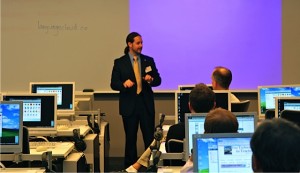
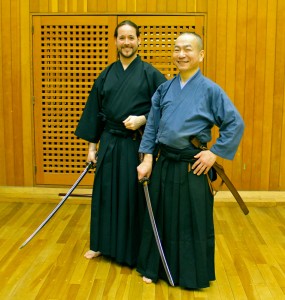
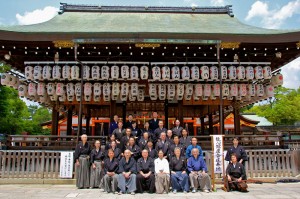
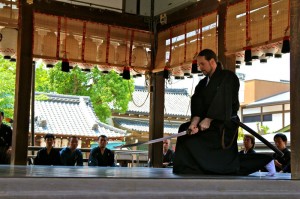

 Connect with me on LinkedIn
Connect with me on LinkedIn Follow me on Twitter
Follow me on Twitter Like me on Facebook
Like me on Facebook Read my RSS Feed
Read my RSS Feed